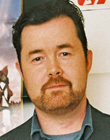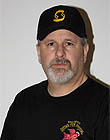|
|
This topic comprises 2 pages: 1 2
|
|
Author
|
Topic: Being silent in true form in a 16-plex
|
Ralph Martin
Film Handler
Posts: 30
From: Vacaville, Ca./ USA
Registered: Jul 2008
|
 posted 07-23-2011 01:19 PM
posted 07-23-2011 01:19 PM




FIRST, A FUNNY TRUE STORY:
So, this young couple walked into Brenden Theaters (our local 16-plex) with puzzled looks on their faces, watching a load of musical instruments being moved into auditorium #16. The young lady just had to ask me as she walked by, “Like…what’s going on here?” Never too busy to help a movie fan, I replied, “We’re loading in the orchestra for a silent movie.” With amazement she asks, “You mean they’re going to play the music for the movie, like… in person?” I nodded. After a pause for what looked like some serious consideration she said, “Wow! Is this like a NEW kind of thing??” I said, "Yes, it's called 3D SOUND!" :-)
NOW MY DILEMMA:
Well, thanks to the help of the many knowledgeable techs here on this forum our high school orchestra is about to perform their 5th silent movie, Harold Lloyd’s SAFETY LAST (1923) this August at Brenden Theaters and the tickets are almost all sold out three weeks before the performances begin. Now I’m forced to make a leap that I was hoping to avoid.
After being assured by Mr. Lloyd’s estate that SAFETY LAST will run fine at 24fps, I am now informed by others – including the film archives at UCLA that the print must be run at variable speeds between 20 and 22fps.
We have discussed ways to slow down a modern film projector on this forum before. I just hope that the Harold Lloyd Trust is right and the print WILL run at 24fps. It’s getting a little too close to the performance dates to start worrying about altering the theater’s projector :-/
Anyone here have any experience with Harold Lloyd’s films?
| IP: Logged
|
|
|
|
|
|
|
|
|
|
|
|
Paul H. Rayton
Expert Film Handler
Posts: 210
From: Los Angeles, CA , USA
Registered: Aug 2003
|
 posted 07-23-2011 04:32 PM
posted 07-23-2011 04:32 PM



I ran a 35mm print of this film ("Safety Last") back in Feb. in the San Diego Symphony Orchestra's theatre, Copley Symphony Hall in San Diego (nee "Fox Theatre" , San Diego). However, this screening wasn't with the orchestra, it was with their newly-refurbished Robert Morton pipe organ (which sounds terrific, BTW). And, one more aside, the light source for film projection there is carbon arc, so it's a total retro experience, for sure.
At any rate, my notes from the screening said: "Ran at 24fps. COULD be run slower, as action is a bit fast". The theatre installation is actually capable of variable speeds, but they opted to go with the faster rate because, sadly, today's audiences don't exactly have the same ability to appreciate movies with intertitles as they did almost 90 years ago, so, to keep the storyline moving, the faster frame rate was considered acceptable.
It's a judgement call, really. Yes, once upon a time it may have been projected at a slower rate, but on the other hand, if you can do a reasonable approximation of the original screen experience, and not run seriously afoul of today's finicky audience tastes, there's probably no harm done to run it slightly faster.
On the other hand, there are some older films, esp. dramatic ones, that more or less demand slower frame rates, down to as slow as 18fps. "Safety Last" is a comedy, and it doesn't particularly hurt to have it slightly sped up.
| IP: Logged
|
|
Leo Enticknap
Film God

Posts: 7474
From: Loma Linda, CA
Registered: Jul 2000
|
 posted 07-23-2011 06:03 PM
posted 07-23-2011 06:03 PM





As Paul says, determining the speed is basically a judgment call. However, there are a few guidelines.
1 - the speed at which a film was shot in the camera and the speed at which the filmmakers intended it to be projected was not always the same. With slapstick comedies especially, it frequently happened that the filmmaker wanted a slightly higher projection speed than shooting speed in order to make the stunts look more spectacular. I don't know about Safety Last specifically, but there are surviving flyers that were put in the cans of prints of The General sent to theatres stating that it should be run at 24 (or 90 feet per minute - in those days, projection speeds were more commonly expressed in feet per minute than frames per second). I've seen one in the BFI Special Collections library.
2 - a sort of projection speed arms race happened during the '20s. Theatres wanted to increase speeds for two reasons. Firstly there was the phenomenon of so-called 'picture racing', which you'll find multiple references to in the trade papers of the time. Basically, in the case of longer films, theatres would run them faster to squeeze an extra show into the day. Secondly, as the '20s progressed and the bigger picture palace theatres started to be built, two-blade shutters started to be used in theatres to maximise light output. A two-blade shutter needs a higher speed to eliminate visible flicker. The studios responded to this trend by increasing shooting speeds. The main reason why 24fps was adopted as the sound standard is essentially because it had become a de facto standard projection speed by the late '20s anyway. By 1925-26, studios were working on the assumption that theatres would project at 24, and if they shot at a lower speed if was usually for a specific reason and with the intention that the footage should be projected faster.
3 - This rule of thumb applies a lot less to European films. In particular, most German and USSR silents were shot at 16-18 and intended to be projected at that speed right up until the conversion to sound. From the early 1920s onwards, 18-20 in France and 20-22 for Britain is a usually accurate rule of thumb.
quote: Paul Rayton
I ran a 35mm print of this film ("Safety Last") back in Feb. in the San Diego Symphony Orchestra's theatre, Copley Symphony Hall in San Diego (nee "Fox Theatre" , San Diego). However, this screening wasn't with the orchestra, it was with their newly-refurbished Robert Morton pipe organ (which sounds terrific, BTW).
Have there ever been any open-air silent screenings with the organ in Balboa Park? That would certainly be worth a trip!
| IP: Logged
|
|
|
|
Leo Enticknap
Film God

Posts: 7474
From: Loma Linda, CA
Registered: Jul 2000
|
 posted 07-24-2011 08:08 AM
posted 07-24-2011 08:08 AM





quote: Ralph Martin
If the print I am getting has an included digital soundtrack it is obviously either "stretch printed", as Scott suggested, or is just accepted to run at 24fps as suggested by the others here.
I did see a modification to the Dolby digital system demonstrated at an AMIA conference a few years ago, whereby the number of channels encoded was reduced to 2.0 (i.e. the volume of data that had to be captured each second was reduced) in order to enable lower speed running. They demonstrated it with a Chaplin short from the early teens and it seemed to work fine. My memory is hazy, but if I remember correctly the only modification needed in the theatre (apart from a variable speed motor and three-blade shutter on the projectors, obviously) was a new firmware version in the CP. One very clever feature was that the correct projection speed was encoded into the Dolby data blocks, so that as soon as the first block was read a signal was sent to the inverter supplying power to the projector's motor, which automatically set the 'correct' (as in, what the archivists who restored the film believe is correct) speed. The projectionist just had to lace up and run, exactly as he or she would with a normal sound print. I don't know if this ever progressed beyond the experimental stage. I liked the idea of it, because with the audio data between the perfs you don't need to optically reduce the silent frame from full-gate to Academy, and so to release a film this way all you need to do is to print from an existing full-gate preservation negative and a new Dolby digital optical sound negative.
quote: Ralph Martin
I don't get it --- Sunrise was released in 1927 with its score on an optical soundtrack. could you imagine what the soundtrack would have sounded like in 1927 if the projectionist kept changing the speed during the movie??? It had to be a constant 24fps. Or is there something I 'm just not getting about the speed thing?
You've got it right - Sunrise runs at 24. The only early sound issues to watch out for are De Forest Phonofilms (80 ft/min or about 21.5fps) and a very few very early RCA Photophones (85ft/min or 22fps). Fox Movietone and Warners' Vitaphone were 24 from the beginning and always.
| IP: Logged
|
|
|
|
|
|
|
|
|
|
|
|
|
|
All times are Central (GMT -6:00)
|
This topic comprises 2 pages: 1 2
|
Powered by Infopop Corporation
UBB.classicTM
6.3.1.2
The Film-Tech Forums are designed for various members related to the cinema industry to express their opinions, viewpoints and testimonials on various products, services and events based upon speculation, personal knowledge and factual information through use, therefore all views represented here allow no liability upon the publishers of this web site and the owners of said views assume no liability for any ill will resulting from these postings. The posts made here are for educational as well as entertainment purposes and as such anyone viewing this portion of the website must accept these views as statements of the author of that opinion
and agrees to release the authors from any and all liability.
|

 Home
Home
 Products
Products
 Store
Store
 Forum
Forum
 Warehouse
Warehouse
 Contact Us
Contact Us




 Printer-friendly view of this topic
Printer-friendly view of this topic














